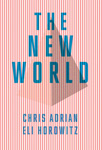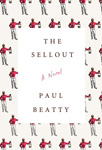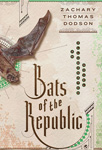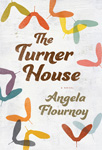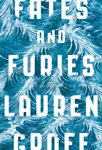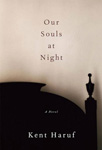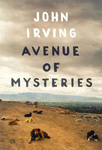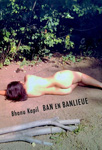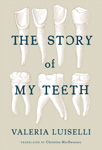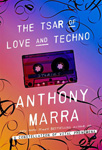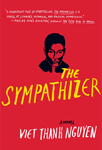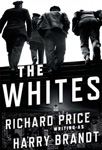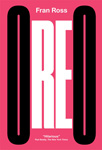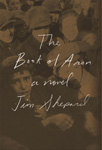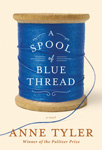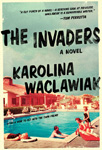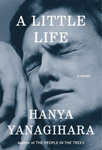by Chris Adrian and Eli Horowitz
Buy it at Powell’s »Kit Rachlis: If bookies in the UK—a civilized country where betting on who will win book contests is not only allowed but encouraged—had known in advance that I had to choose between Viet Thanh Nguyen’s The Sympathizer and Zachary Thomas Dodson’s Bats of the Republic, they would have given extremely favorable odds to The Sympathizer.
It is a spy novel, and I belong to that large club of readers who believe that the spy novel has joined detective fiction as one of literature’s most protean genres. (And, yes, John le Carré’s Tinker Tailor Soldier Spy is still the form’s greatest achievement.) It is about the aftermath of the Vietnam War—a war that affected my life in direct and indirect ways. Better yet, it is a Vietnam War novel in which the Vietnamese are the primary characters, not Americans, something extremely rare in the thousands (hundreds of thousands?) of novels the war has produced.
Further, it takes place in Southern California, where I have spent most of the past 27 years and which remains, to my prejudiced mind, one of the most misunderstood places in the United States: an object of endless cliché, stereotype, envy, and superciliousness in the hands of too many writers who should know better but don’t. But like the best writing in which Southern California plays a central role, The Sympathizer looks past the region’s surfaces—its malls and freeways and palm trees—and burrows deeply into its mysteries and contradictions. And then there is Nguyen’s writing, a high-wire act of metaphor, rhythm, and deceptive simplicity. Just one example among many:
Fabricated of supple brown leather by an esteemed New England manufacturer, the rucksack smelled richly, mysteriously of autumn leaves, grilled lobster, and the sweat and sperm of boys’ boarding schools. A monogram of my initials was branded on the side, but the most special feature was the false bottom. Every man should have a false bottom in his luggage, Claude had said.
On the other side is Bats of the Republic, a meta-novel, a novel within a novel within a novel (if I’m counting right). Its genre—to be fair, one of the many genres it plays with—is steampunk, which you’ll never convince me will ever reach the heights of the detective or spy novel. It is also self-consciously showy, throwing a kitchen sink worth of effects at the reader: letters from three of the principal characters, drawings from two of the principal characters, transcripts of overheard conversations, diagrams, a 19th-century novel rendered so realistically that a worm appears to have eaten through the pages, and a 22nd-century novel (or is it a novel written in the 19th century about the 22nd century?). That’s just a sample of what you have to navigate.
The plots—once again, to be precise, its numerous plots—are old-fashioned melodramas in which the narrative depends on characters not talking to one another at key turns and discovering the error of their ways just in time. And the language can be rickety:
A violent wind was kicking up dust outside. It hissed against the walls. He would have to search the entire unit. He looked everywhere. All the cupboards, the drawers, the closets. Under the sparse wooden furniture. Every corner. Inside the end of the phonotube. Everywhere the Major would have looked. The letter was not inside the unit.
Throw in some real and made-up history of Texas (a place that, like Southern California, feels perpetually misunderstood), and you have a novel that, by every right, shouldn’t speak to me.
So why am I selecting Bats of the Republic over The Sympathizer?
Both are first novels into which the writers have poured everything they have (and, it seems, everything they can think of). The first 50 pages of The Sympathizer, especially, are a tour de force—an impossible-to-duplicate model of how to put all the pieces in place to set up an ambitious story. Chronicling the fall of Saigon to the Viet Cong in 1975, the opening chapters introduce all the major characters; convey the panic, lackadaisical violence, and ordinary deceit of the city’s inhabitants; and offer a bit of mystery, all conveyed by a narrator whose voice is seductively nonchalant and acidly observant. By the fourth chapter, I couldn’t imagine The Sympathizer not winning. But then the book starts to flag. The bravura of the writing too often calls attention to itself, and the book’s grand themes of divided loyalties, dual identities, friendship and duty, revolution and betrayal, at times feels overly schematic. It’s not until the end that the pace picks up again.
When I initially turned to Bats of the Republic, all the razzmatazz was off-putting—simply there for its own sake. But soon it’s clear it has a purpose. That rickety language and melodramatic plot? They are homages to the dime novel and early sci-fi. All those letters and illustrations and diagrams? Dodson began his career as a book designer, and he wants Bats of the Republic to be more than just a literary experience, but a visual and tactile one. (The subtitle, after all, is An Illuminated Novel.) And what about that story within a story within a story? It’s not an academic exercise. Bats of the Republic is meant to be a Möbius strip of a novel. (This is not an image plucked out of the air. The book’s MacGuffin—a lost letter tucked into an envelope deep in the book—comes in the form of a Möbius strip.) Each flourish, from the design of the book jacket’s to Dodson interjecting himself as an unspoken character, folds back in on itself and fits into a larger whole. Bats of the Republic, it turns out, is a meditation on storytelling and novel-making that is dazzling and, to my great surprise, moving.
Match Commentary
By Kevin Guilfoile & John Warner
Kevin: John, I know the opening round started off with a shock as Fates and Furies went down to Bats of the Republic, and I suspect you find this result no less surprising. As much as I enjoyed The Sympathizer, though, I think I would have picked the same way as Judge Rachlis. He says Bats of the Republic has “razzmatazz,” and I tell you what, I like that about it, too.
One of the big buzz books of last year was City on Fire by Garth Risk Hallberg, and it boasted some of the same kinds of razzmatazz that Bats does. (For instance, City on Fire includes a very cool punk fanzine, published in all its cut-and-paste, bedroom-design glory.) If you heard about Bats of the Republic in 2015 it might have been in the last paragraph of one of the many articles written about City on Fire, where it was entered as evidence that the “illuminated novel” is a publishing trend. I enjoyed City on Fire quite a lot, but the much more compact Bats takes that concept further, with far greater attention to detail, and I just liked it better. It is gimmicky, for sure, but it’s a gimmick I can go for, executed with a commitment I admire.
John: Before a single word was read in 2015, any interested prognosticator would’ve put City on Fire in the tournament. With its big advance came interest, curiosity, and hype—probably too much for any book to live up to. Having your book called the “next Great American Novel” after only a handful of people have read it must be exciting as hell, but set next to that standard any novel is going to fall short. And while the novel was highly praised in a lot of quarters (including a rave from Michiko Kakutani), it never caught the public fancy of something like The Goldfinch or All the Light We Cannot See.
Of course, that hype meant it sold more than 99 percent of the novels released in a given year. City on Fire was perhaps not the phenomenon all involved were hoping for, but still, not too bad.
Bats of the Republic gets to approach the reader as a curiosity, and I think that works in its favor in terms of the expectations game. When you don’t know enough to expect something specific, you can accept whatever you get. If you look at the reader reviews of City on Fire, there’s a lot of praise to be found, but there’s also a heavy dose of, “It’s not all that.”
Part of the pleasure of Bats seems to be in figuring out exactly what it is.
Kevin: Judge Rachlis mentions how one of the novels within the novel is “rendered so realistically that a worm appears to have eaten through the pages.” But in an entirely different section of the (real) book, we learn that a soldier was shot while carrying that (made-up) novel in his coat pocket. That’s not a worm hole, it’s a bullet hole—something that seems at first like a meaningless piece of filigree, but actually serves a narrative purpose. It’s a minor detail, and I don’t blame Judge Rachlis for missing it. No doubt Dodson fired plenty of other bullets that whizzed past my ear. It is fun to happen upon those synchronicities, and I love the care (and restraint) with which Dodson placed them throughout the novel for us to find (or not).
John: It’s a cool detail, and there’s something satisfying in knowing this, but the reason that I find a second victory for Bats even more surprising, or perhaps just disappointing, is because the underlying narrative of Bats barely raised my emotional temperature. The Sympathizer makes me believe that I’m reading the true account of a living, breathing person. It puts me fully under the spell of its fictive dream, and as far as I’m concerned, everything in that novel happened.
It’s not that I read Bats saying to myself: This couldn’t happen. There’s nothing in the story’s construction that caused me to question my own willing suspension of disbelief. But in the end, I just wasn’t sufficiently connected to the work to care if it really happened.
Kevin: Science fiction and fantasy generally require more of a buy-in from the reader, right? An author has to work a little harder to make us care about a Hobbit like Frodo Baggins than he does a nine-year-old girl like Scout Finch. All the the hee-haws and doo-whats of a genre like steampunk can serve as reminders that none of this is real, distancing us from the characters. The true-to-life details of historical fiction, on the other hand, can facilitate the fictional sleight of hand.
A few weeks before reading The Sympathizer I watched the PBS documentary Last Days in Vietnam, which had hours of incredible footage from the fall of Saigon. Those images were fresh in my head as I immersed myself in the opening chapters. I didn’t have the same kind of help with Bats, but I was more than willing to work with Dodson in order to get there. To enjoy any novel a reader needs to feel like a collaborator in the author’s vision, not a hostage of it. I think with Bats of the Republic I felt more like the former and you felt more like the latter.
Hey, John, we get another day off tomorrow! The next matchup, between Angela Flournoy’s The Turner House and Kent Haruf’s Our Souls at Night, will be analyzed and dissected and generally obsessed over by Ann Kingman and Michael Kindness, hosts of the excellent Books on the Nightstand podcast. I will probably spend the break binge-watching old seasons of The Amazing Race with my nine-year-old, who just discovered it. You and I should be on that show one day. Team Rooster!
The odds of a television network pairing up teams of novelists for a reality show seems remote in the extreme, but I think with serious money on the line we could be as bungee-jumpy and backstabby as the next fellows.
One final note: When Drew and Christopher took over the commentary booth last week, they joked about stealing mugs from the booth—a joke that was picked up on by the commentariat, who said they wanted mugs too. So we went ahead and made some mugs in the form of the 2016 Tournament of Books Mug Collection. Drink up!

The official 2016 Tournament of Books T-Shirt by book designer Janet Hansen. Order yours!


